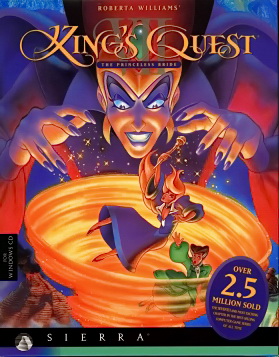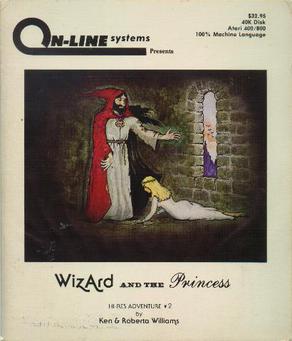
King's Quest is a graphic adventure game series, released between 1980 and 2016 and created by the American software company Sierra Entertainment. It is widely considered a classic series from the golden era of adventure games. Following the success of its first installments, the series was primarily responsible for building the reputation of Sierra. Roberta Williams, co-founder and former co-owner of Sierra, designed all of the King's Quest games until the series' reboot in 2015.
The Adventure Game Interpreter (AGI) is a game engine developed by Sierra On-Line. The company originally developed the engine for King's Quest (1984), an adventure game that Sierra and IBM wished to market in order to attract consumers to IBM's lower-cost home computer, the IBM PCjr.

Gobliiins is a puzzle adventure video game series, consisting of five entries, released by Coktel Vision for the Amiga, Atari ST, DOS, and Macintosh platforms. The first three titles were released in the early 1990s, the fourth in 2009. The visual look of the series and its characters were created by French artist Pierre Gilhodes, whose style was used in another game from Coktel Vision: Woodruff and the Schnibble of Azimuth.

Castlevania II: Simon's Quest is a platform-adventure game developed and published by Konami. It was originally released in Japan in 1987 for the Famicom Disk System, and in North America in 1988 for the Nintendo Entertainment System. It is the second Castlevania game released for the NES, following the original Castlevania (1986). Set seven years after the events of the first installment, the player once again assumes the role of vampire hunter Simon Belmont, who is on a journey to undo a curse placed on him by Dracula at the end of their previous encounter. Dracula's body was split into five parts, which Simon must find and bring to the ruins of Castle Dracula in order to defeat him. The game deviates from the traditional platforming of its predecessor, incorporating role-playing and open world elements.
AGD Interactive (AGDI), LLC. is a non-profit company given a fan license to remake Sierra Entertainment's popular classic adventure games from the 1980s and early 1990s.

King's Quest: Quest for the Crown is an adventure game developed by Sierra On-Line and published originally for the IBM PCjr in 1984 and later for several other systems between 1984 and 1989. The game was originally titled King's Quest; the subtitle was added to the games box art in the 1987 re-release, but did not appear in the game.

King's Quest III: To Heir Is Human is the third installment in the King's Quest series of graphic adventure games developed and released by Sierra On-Line in 1986. The game was originally released for the Apple II and PC DOS, and later ported to several other computer systems. It was the first title game in the series not to feature King Graham as the player character.

King's Quest IV: The Perils of Rosella is a graphic adventure game developed and released by Sierra On-Line for the MS-DOS, Amiga, Apple II, Apple IIGS, and Atari ST computers in 1988. The player takes on the role of Princess Rosella, daughter of King Graham of Daventry and the twin sister of Gwydion/Alexander, who must save her father and a good fairy and destroy an evil witch. Critically acclaimed, it was one of the first PC games to support a sound card.

King's Quest V: Absence Makes the Heart Go Yonder! is a 1990 graphic adventure game by Sierra On-Line. Originally released in November 1990, it featured a significant improvement in graphics. It was also the first King's Quest installment to replace the typing user interface with a point-and-click user interface. The title is a spoof on the proverb "Absence makes the heart grow fonder".

King's Quest VI: Heir Today, Gone Tomorrow is a point-and-click adventure game, first released in 1992 as the sixth installment in the King's Quest series produced by Sierra On-Line. Written by Roberta Williams and Jane Jensen, King's Quest VI is widely recognized as the high point in the series for its landmark 3D graphic introduction movie and professional voice acting. King's Quest VI was programmed in Sierra's Creative Interpreter and was the last King's Quest game to be released on floppy disk. A CD-ROM version of the game was released in 1993, including more character voices, a slightly different opening movie and more detailed artwork and animation.

King's Quest VII: The Princeless Bride is a graphic adventure game developed and published by Sierra On-Line for the MS-DOS, Microsoft Windows and Macintosh computers in 1994. It features high-resolution graphics in a style reminiscent of Disney animated films and is the only King's Quest game with multiple protagonists: Queen Valanice and Princess Rosella, who are both spirited away to the realm of Eldritch, and Rosella is transformed into a troll. They must find a way to return Rosella to normal and find her true love, get rid of a powerful evil force threatening this realm, and get back to their kingdom Daventry.

Space Quest: Chapter I – The Sarien Encounter is a graphic adventure game, created by Scott Murphy and Mark Crowe, and released in October 1986 by Sierra On-Line. It is the first game in the Space Quest series, and sees players assume the role of a lowly janitor on a research ship, who becomes involved in stopping an alien race using a new form of technology for evil purposes.
The King's Quest Companion is a book by Peter Spear that serves as both hint book/walkthrough and contained complete novelization of each of the games in the King's Quest series by the original Sierra On-Line company. The first three editions were published by Silicon Valley Books, and fourth edition by Osborne/McGraw-Hill. The novelization for KQ6 was written by a guest writer, Eluki Bes Shahar.

Wizard and the Princess is a graphic adventure game written for the Apple II and published in 1980 by On-Line Systems. It was the second title released in the Hi-Res Adventures series after Mystery House. While Mystery House used monochrome drawings, Wizard and the Princess added color. Ports for the Atari 8-bit family and Commodore 64 were released in 1982 and 1984 respectively. The 1982 self-booting version for IBM PC compatibles was renamed Adventure in Serenia.

Police Quest: In Pursuit of the Death Angel is a 1987 police procedural adventure video game developed and published by Jim Walls and Sierra On-Line. Police Quest follows police officer Sonny Bonds as he investigates a drug cartel in the town of Lytton, California.

King's Quest: Mask of Eternity is a hybrid point-and-click adventure and action-adventure video game developed and published by Sierra Studios in 1998. It was the eighth official game in the King's Quest series, the first and only game in the main series where the main character is neither King Graham nor a member of his family, as well as the first in the series to use a full 3D engine as opposed to the 2D cartoon or pixel style of the earlier games and the first to omit the sequel numbering system on box artwork and title screen.
King's Quest II: Romancing the Stones is a fangame reimagining/retelling of Sierra Entertainment's King's Quest II: Romancing the Throne by AGD Interactive produced through a fan license by Sierra Entertainment. It was followed up by King's Quest III: To Heir Is Human. In 2009, the version 3.0 Enhanced Edition was released, with improved graphics and full-speech narration. The game earned the AGS award for best music and game in 2002.
King's Quest III: To Heir is Human is a VGA-style fangame remake/reimagining/retelling of Sierra Entertainment's King's Quest III: To Heir Is Human by Infamous Adventures. It was released on June 19, 2006. A slightly expanded remake offers new material including; new cutscenes, a few new characters, expanded narration or dialogue, additions and changes to some of the plot, full speech, new or modified locations, and Easter eggs. Most of the original puzzles remain intact or item placement changed. The game received the AGS reward for best documentation in 2006.
There have been several King's Quest fangames both original and retellings/remakes of the original games that have been released by various developers.

King's Quest is an episodic video game series developed by The Odd Gentlemen and published by Activision under the Sierra Entertainment brand name for Microsoft Windows, PlayStation 3, PlayStation 4, Xbox 360 and Xbox One. It is a new re-imagining of the long-running King's Quest series. While it is an adventure game like the previous games in the series, the interface is not fully point-and-click.















